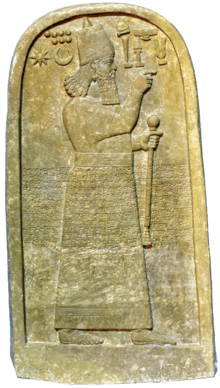Shu-Ninua
Shu-Ninua or ŠÚ- or Kidin-Ninua, inscribed mŠÚ-URU.AB x ḪA,[i 1][i 2] the 54th king to appear on the Assyrian Kinglist, was the ruler of Assyria, ca. 1615-1602 BC (short chronology) or 1567-1554 BC (ultra-short), and was the son of his predecessor-but-one, , succeeding the presumed usurper, Lullaya, a “son of nobody.”[1]
| Shu-Ninua | |
|---|---|
| King of Assyria | |
| King of the Old Assyrian Empire | |
| Reign | 1615–1602 BC |
| Predecessor | Lullaya |
| Successor | Sharma-Adad II |
| Issue | Sharma-Adad II |
| Father | Bazaya |
Biography
The reading of the first element in his name is uncertain, as Ignace Gelb and Benno Landsberger originally proposed BAR, giving Kidin-Ninua, "[Under] the protection of Nineveh," while Arno Poebel read the name as beginning with [Š]Ú- and Weidner read it as [Š]I- on another fragmentary copy of the kinglist.[i 3] J. A. Brinkman observed that with the exception of this disputed interpretation, all transliterations gave ŠÚ, reinforced by the Synchronistic Kinglist,[i 4] ˹mŠÚ-ni˺-nu-a, which had led to the preponderance for interpreting his name as Shu-Ninua in recent years,[2] “he of Ishtar,”[3] if Nina is correctly identified as a Babylonian name for this deity, although this remains unproven. A recleaning of the fragmentary kinglist,[i 3] however, has revealed a name collated by Heeßel to be [mki-d]in-dNINUA.[4]
There are no contemporary inscriptions of his reign.[5] He is recorded as having been a contemporary of Akurduana of the Sealand Dynasty in southern Babylonia in the Synchronistic Kinglist,[i 4] rather than any supposed ruler from the Kassite dynasty. The Assyrian Kinglist records that he reigned for fourteen years before being succeeded by his sons, Sharma-Adad II and then Erishum III.
Inscriptions
- Khorsabad Kinglist, tablet IM 60017 (excavation nos.: DS 828, DS 32-54). ii 24, 26, 28 and 35,
- SDAS Kinglist, tablet IM 60484, ii 20, 21, 22 and 27.
- Kinglist fragment VAT 9812 (KAV 14), 6.
- Synchronistic Kinglist, Ass. 14616c, i 8.
References
- K. Radner (1999). The Prosopography of the Neo-Assyrian Empire, Volume 1, Part II: B–G. The Neo-Assyrian Text Corpus Project. p. 278.
- J. A. Brinkman (1973). "Comments on the Nassouhi Kinglist and the Assyrian Kinglist Tradition". Orientalia. 42: 318–319.
- šu, CAD Š 3, p. 160.
- Nils P. Heeßel (2003). "Zur Lesung der Königsnamens ŠÚ-URU.NINA". NABU (3): 60–61.
- A. K. Grayson (1975). Assyrian and Babylonian chronicles. J. J. Augustin. pp. 31–32.
| Preceded by Lullaya |
King of Assyria 1615–1602 BC |
Succeeded by Sharma-Adad II |
